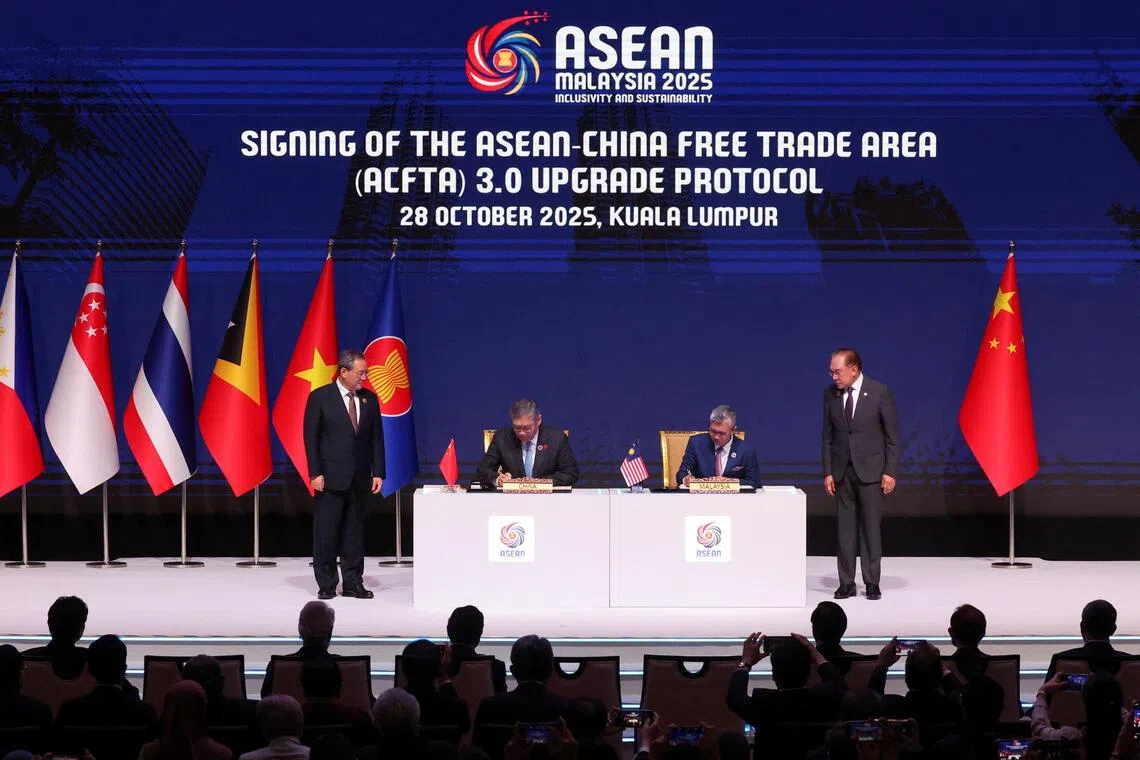China and Asean, hit by US tariffs, sign upgraded free trade pact
Sign up now: Get ST's newsletters delivered to your inbox

Chinese Premier Li Qiang (far left) and Malaysian PM Anwar Ibrahim (far right), the current Asean chair, witnessing the signing of the Asean-China Free Trade Area 3.0 agreement on Oct 28.
PHOTO: REUTERS
Follow topic:
KUALA LUMPUR – Asean and China on Oct 28 signed an upgrade to their free trade agreement, with leaders hailing the deal which spans the digital and green economy, and other new industries.
The 11-member South-east Asian grouping is China’s largest trading partner, with bilateral trade totalling US$771 billion (S$998 billion) in 2024, according to Asean statistics.
China is seeking to intensify its engagement with Asean, a region with a collective gross domestic product of US$3.8 trillion, to counter hefty import tariffs imposed by US President Donald Trump’s administration on countries around the world.
“We must accelerate trade and investment liberalisation and facilitation and strengthen industrial integration and interdependence,” Chinese Premier Li Qiang said at the Asean leaders’ meeting on Oct 28.
Beijing has been seeking to position itself as a more open economy, despite criticism from other major powers of its expanding export restrictions on rare earths and other critical minerals.
The so-called 3.0 version of the free trade agreement with Asean was signed into effect
Negotiations on the upgraded Asean-China deal began in November 2022 and concluded in May 2025, just after Mr Trump’s tariff offensive kicked into gear. Their first FTA came into force back in 2010.
“The upgrade will further reduce trade barriers, strengthen supply chain connectivity, and unlock opportunities in future growth areas,” Singapore’s Prime Minister Lawrence Wong said.
China has previously said the agreement would pave the way for improved market access in sectors such as agriculture, the digital economy and pharmaceuticals between China and Asean.
Both China and Asean are part of the Regional Comprehensive Economic Partnership (RCEP), the world's largest trading bloc, which covers nearly a third of the global population and about 30 per cent of global gross domestic product.
Malaysia hosted an RCEP summit in Kuala Lumpur on Oct 27, the first in five years.
RCEP is seen by some analysts as a potential buffer against tariffs imposed by the United States, though its provisions are considered weaker than some other regional trade deals due to competing interests among its members.
Flashpoint waterway
Standing in the way of China taking a leading role in regional trade cooperation are heightened concerns around Beijing’s military ambitions.
On Oct 27, Philippine President Ferdinand Marcos Jr criticised Chinese aggression in the South China Sea, where the two countries have been engaged in a series of confrontations.
Beijing’s foreign office responded to Mr Marcos’ statement by saying the clashes were due to provocation from Manila.
China claims almost the entire resource-rich waterway on its official maps, overlapping with parts of the exclusive economic zones of Brunei, Indonesia, Malaysia, the Philippines and Vietnam.
Unresolved disputes have festered for years over ownership of multiple islands and features.
“We must strengthen strategic mutual trust,” Mr Li said in his Oct 28 address. “We must accelerate consultations on the Code of Conduct in the South China Sea and strive for an early conclusion.”
Mr Wong also raised the flashpoint as a key diplomatic issue.
“Inevitably, there will be differences of views around the South China Sea, but all of us agree that peace, stability, safety and freedom of navigation and overflight, are critical in this important waterway.”
Trade war truce
China has been engaged in an escalating trade war with the US since Mr Trump took office in January and imposed steep tariffs on Chinese goods.
Beijing has labelled Mr Trump’s tariffs, which have hit most countries, as protectionism, while expanding its controls over the flow of its critical minerals and magnets.
China processes more than 90 per cent of the world’s rare earths.
The world’s two largest economies extended a trade truce when negotiators met in Kuala Lumpur on the weekend, hashing out an agreement for Mr Trump and Chinese President Xi Jinping to decide later this week when they meet in Seoul.
Since Mr Trump departed Malaysia on the morning of Oct 27, China has pressed for increased economic cooperation in the region, stressing the importance of open trade.
“The world must not slip back to the law of the jungle, where the strong prey on the weak,” Mr Li said on Oct 27 at the East Asia Summit regional forum.
“We should more firmly uphold the free trade regime, create a high-standard regional free trade network, and vigorously and effectively advance regional integration.” REUTERS

